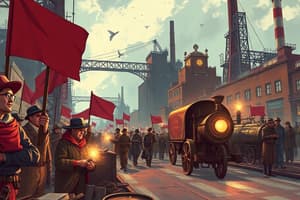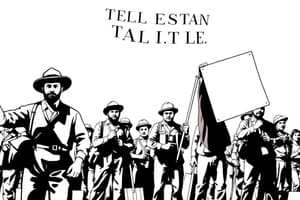Podcast
Questions and Answers
Evaluate the success of organized labor's campaign to improve the position of workers in the period from 1875 to 1900. What factors would explain this outcome?
Evaluate the success of organized labor's campaign to improve the position of workers in the period from 1875 to 1900. What factors would explain this outcome?
The organized labor campaign was a success due to workers' determination, limited immigration by Congress, and the achievement of 10-hour workdays.
Compare goals, strategies, and degree of success labor leaders achieved between 1880 and 1915.
Compare goals, strategies, and degree of success labor leaders achieved between 1880 and 1915.
Compare the attitudes of Andrew Carnegie, Horatio Alger, and Booker T. Washington toward the wealth created in the United States during the late nineteenth century.
Compare the attitudes of Andrew Carnegie, Horatio Alger, and Booker T. Washington toward the wealth created in the United States during the late nineteenth century.
Carnegie believed in vertical integration for the public good; Alger promoted the 'rags to riches' ideal; Washington emphasized skill acquisition for African Americans.
To what extent did economic and political developments and assumptions about the nature of women affect the position of American women during 1890-1925?
To what extent did economic and political developments and assumptions about the nature of women affect the position of American women during 1890-1925?
Evaluate the statement: 'The Progressive movement 1901-1917 was a triumph of conservatism rather than a victory for liberalism.'
Evaluate the statement: 'The Progressive movement 1901-1917 was a triumph of conservatism rather than a victory for liberalism.'
Evaluate the extent to which the federal government changed under President Theodore Roosevelt regarding labor, trusts, conservation, and world affairs.
Evaluate the extent to which the federal government changed under President Theodore Roosevelt regarding labor, trusts, conservation, and world affairs.
Flashcards are hidden until you start studying
Study Notes
Organized Labor Success (1875-1900)
- The organized labor campaign achieved partial success due to workers' persistence in advocating for their rights, leading employers to reconsider wage cuts post-1877 Railroad Strike.
- Congressional actions included limited immigration control, addressing organized labor’s demand, particularly against Chinese laborers and other "undesirable" workers.
- There was an increase in the implementation of ten-hour workdays for many workers, reflecting pre-Civil War labor demands.
Labor Leadership Disagreements (1880-1915)
- Labor leaders held differing views on objectives and methods to improve workers' rights, leading to a fragmented movement.
- Key goals included better wages, working conditions, and hours, but leaders debated the effectiveness of strikes versus political action.
Attitudes Toward Wealth (Late 19th Century)
- Andrew Carnegie: Advocate for vertical integration in steel, believed wealth should benefit society, having risen from poverty to prominence.
- Horatio Alger: Author promoting the "rags to riches" narrative, motivating the poor through stories of success achieved through hard work.
- Booker T. Washington: Former enslaved individual who emphasized vocational training for African Americans, promoting the "bootstrap theory" to foster economic independence.
Economic and Political Developments Impacting Women (1890-1925)
- Economic factors included urbanization and World War I, which increased women’s workforce participation and prompted educational advancements through vocational schools.
- Political developments encompassed the women’s suffrage movement and temperance, alongside the efforts of settlement house workers to improve social conditions.
Progressive Movement Evaluation (1901-1917)
- While the Progressive Movement initiated significant reforms like women’s suffrage and the temperance movement, it can be argued that it primarily preserved traditional conservative values.
- The push for stability and order indicates a prioritization of conservatives’ goals rather than liberal agendas.
Federal Government Changes Under Roosevelt
- Labor: Roosevelt offered limited support for labor, yet established the Square Deal as a framework for fair treatment.
- World Affairs: Introduced the Open Door Policy to maintain U.S. interests in China and used military might as a form of diplomacy.
- Conservation: Implemented the Forest Management Act to protect natural resources, designating areas as national parks and pulling back on resource extraction.
Studying That Suits You
Use AI to generate personalized quizzes and flashcards to suit your learning preferences.




